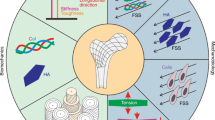Abstract
The current understanding of electromechanical effects in fully hydrated bone is that they are electrokinetic (streaming potential) in nature. The presence of a second competing mechanism, piezoelectricity, which dominates in dry conditions, has been denied in conditions of full hydration based on the absence of a piezoelectric response from wet collagen. Since the mineralized collagenous matrix of bone can only absorb 26 wt% water (Relative Humidity (RH)=60%), there seems no reason to dismiss a piezoelectric component entirely and experimental evidence was sought using a new measuring technique. A comprehensive analysis has been developed to relate both mechanisms to bone structure at different levels of hydration. Our results indicate the presence of both mechanisms at full hydration, with the piezoelectric effect leading streaming potential in the time domain. The immediate implication of this finding is that it is the piezoelectric effect which determines the characteristics of the generated electrical signal and may subsequently influence bone generation and remodelling.
Similar content being viewed by others
References
G. HASTINGS and F. MAHMUD,J. Biomed. Eng. 10 (1988) 515.
S. SINGH and J. KATZ,J. Bioelectr. 7 (1988–9) 219.
D. CHAKKALAKAL,J. Mater. Res. 4 (1989) 1034.
E. KATZ, N. WAX and S. LI, in “Electrical Properties of Bone and Cartilage” edited by C. Brighton, J. Black and S. Pollack (Grune and Stratton, New York, 1979) p. 131.
F. MAHMUD, G. HASTINGS and M. MARTINI,J. Biomed. Eng. 10 (1988) 54.
H. MAEDA and E. FUKADA,Biopolymers 21 (1982) 2055.
J. ANDERSON and C. ERIKSON,Nature 227 (1970) 491.
G. REINISH and A. NOWICK, ibid.253 (1975) 626.
A. MARINO and R. BECKER, ibid.253 (1975) 627.
S. LI and E. KATZ, in “Electrical Properties of Bone and Cartilage” edited by C. Brighton, J. Black and S. Pollack (Grune and Stratton, New York, 1979) p. 119.
G. HASTINGS, F. MAHMUD and M. MARTINI,J. Biomed. Eng. 11 (1989) 403.
S. POLLACK, R. SALZSTEIN and D. PIENKOWSKI,Ferroelectrics 60 (1984) 297.
R. PETHIG, in “Dielectric and Electronic Properties of Biological Materials” (Wiley and Sons, New York, 1979) pp. 15, 70, 100, 329.
G. REINISH and A. NOWICK,J. Retic. Soc. 123 (1971) 283.
J. KOSTERICH, K. FOSTER and S. POLLACK,IEEE Trans. Biomed. Eng. BME-31 (1984) 369.
Author information
Authors and Affiliations
Rights and permissions
About this article
Cite this article
Hastings, G.W., Mahmud, F.A. The electromechanical properties of fluid-filled bone: A new dimension. J Mater Sci: Mater Med 2, 118–124 (1991). https://doi.org/10.1007/BF00703470
Received:
Accepted:
Issue Date:
DOI: https://doi.org/10.1007/BF00703470



